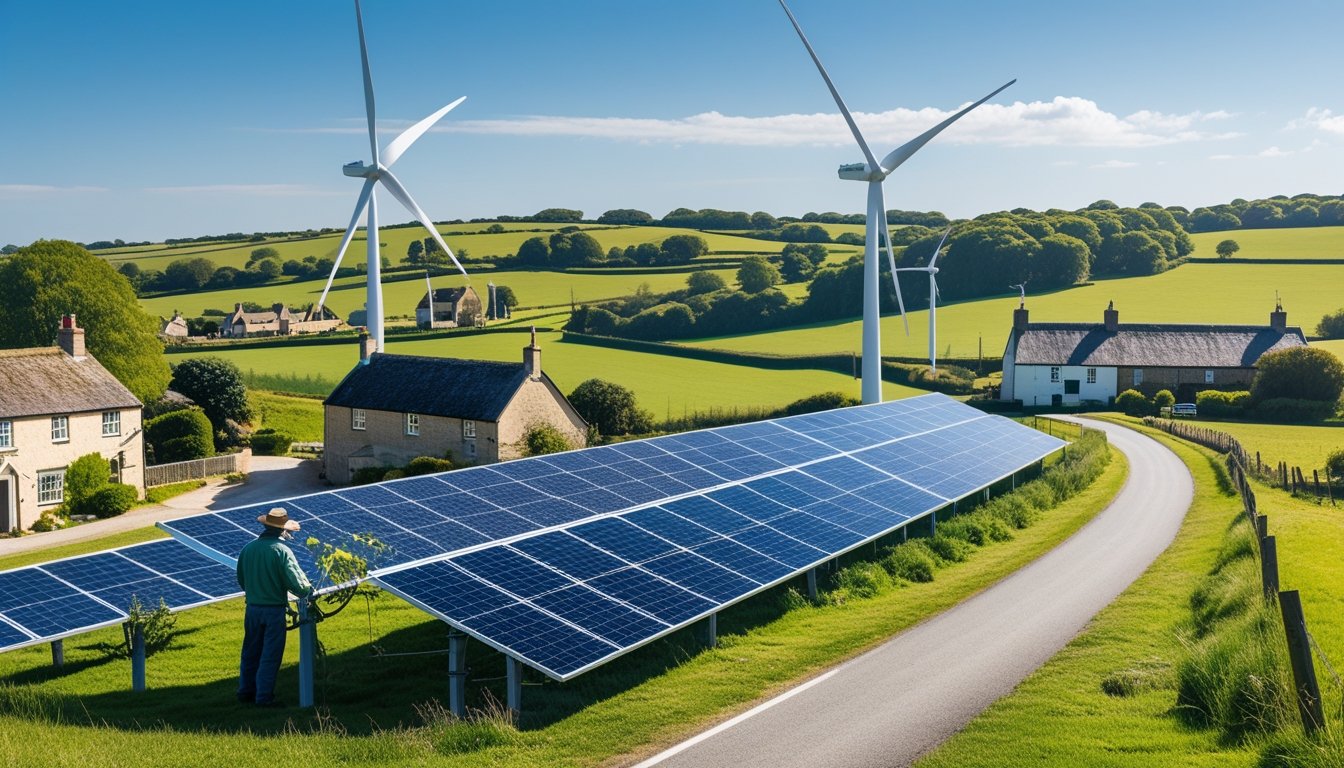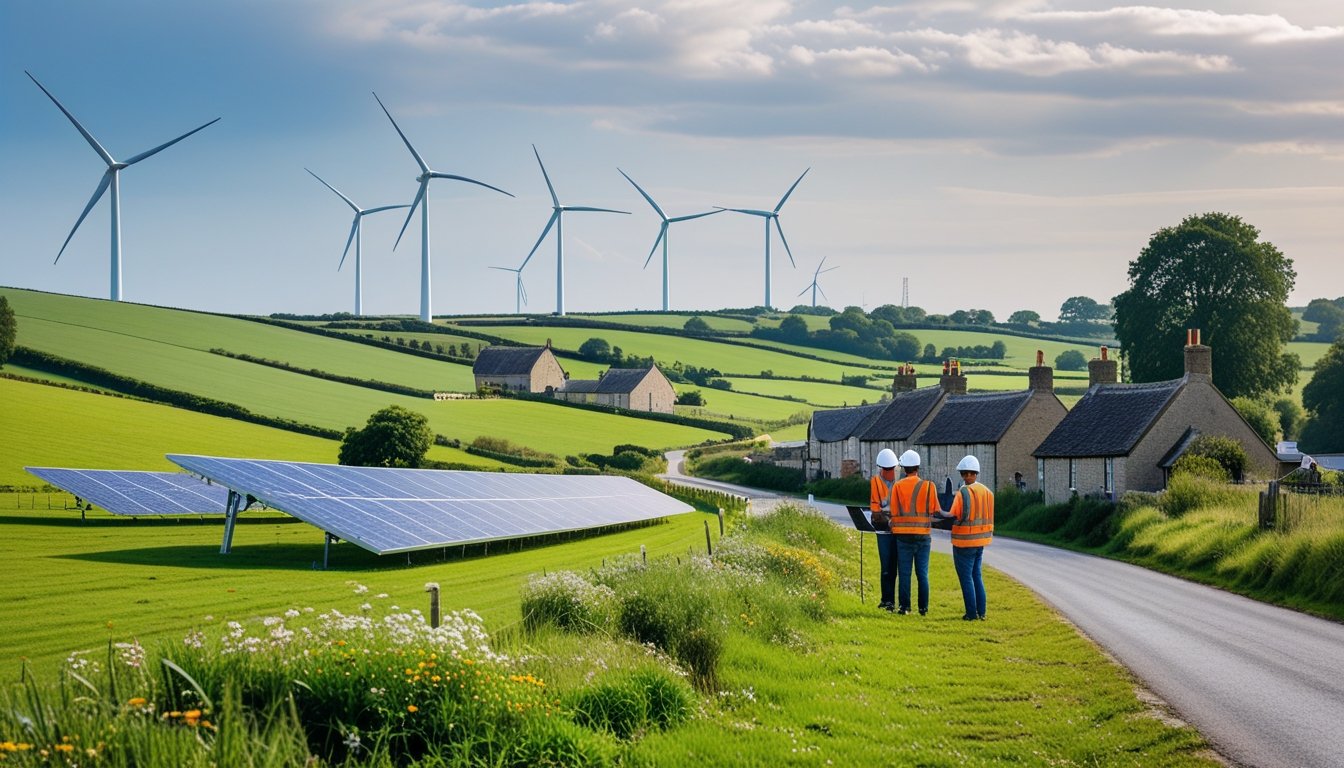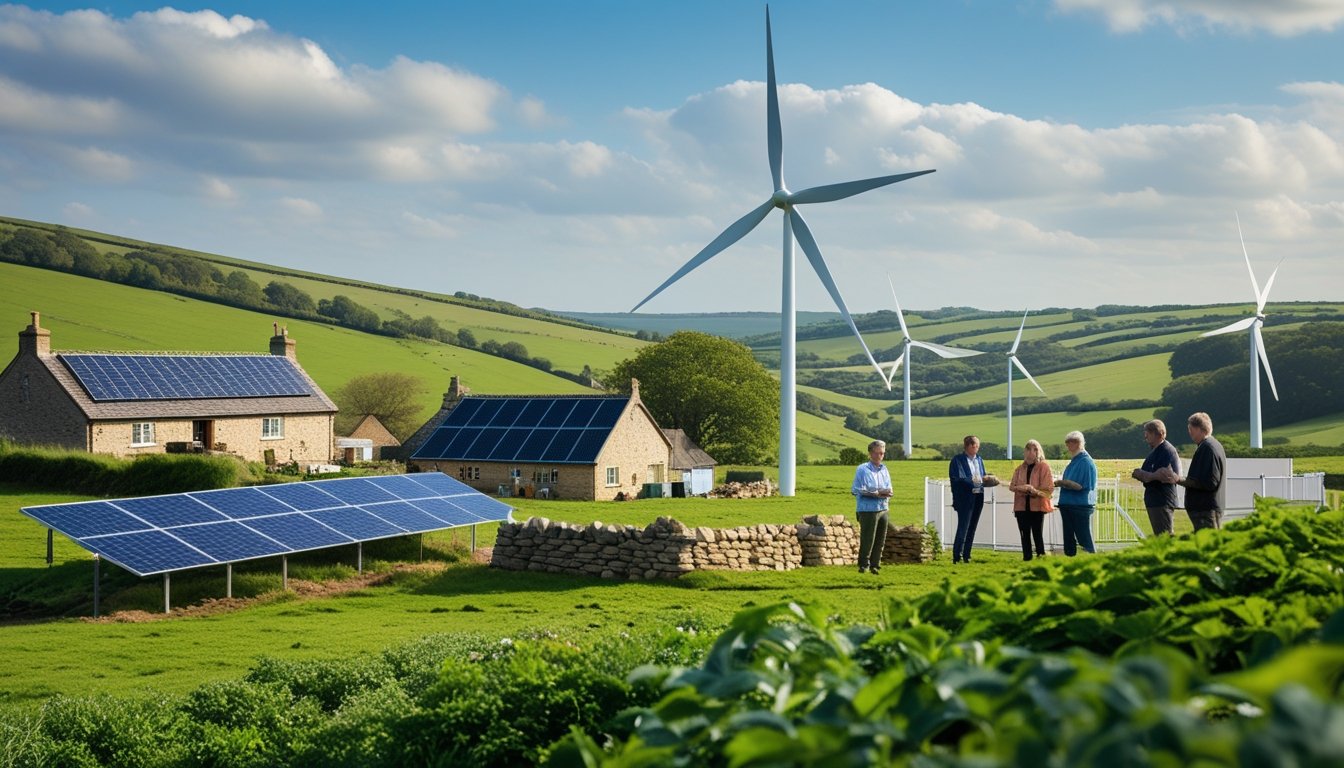Late updated: 07 Jul 2025 14:07
Written by: Oliver Bennett
Improving Renewable Energy Use In UK Rural Areas: Strategies for Sustainable Growth
Harnessing renewable energy in rural areas of the UK is a critical step towards achieving a sustainable future. These regions are rich in natural resources such as wind and solar energy. By strategically deploying renewable energy solutions, we can reduce carbon emissions, decrease energy costs, and enhance the quality of life in rural communities.

Rural areas hold immense potential for renewable energy projects. Initiatives such as solar farms and wind turbines can play pivotal roles in supporting the UK’s ambitious net-zero targets. While these projects promise significant benefits, challenges such as high grid reinforcement costs and infrastructure needs must be addressed to maximise their impact.
Our goal should be to implement solutions that not only work with existing infrastructure but also promote economic growth for local communities. By adopting innovative strategies and policy measures, we can make rural areas leaders in sustainable energy.
Key Takeaways
- UK rural areas have significant potential for renewable energy investments.
- Challenges include infrastructure costs and economic factors.
- Strategic solutions can boost renewable energy use effectively.
Key Strategies for Improving Renewable Energy Use in UK Rural Areas
In rural UK areas, optimising renewable energy use is vital for reducing carbon emissions, enhancing self-sufficiency, and supporting sustainable development. Here, we explore three primary strategies to achieve these goals.
Decarbonising Rural Heating Systems
Decarbonising heating systems is essential for cutting emissions in rural areas. Traditional fossil-fueled systems can be replaced by renewable alternatives such as heat pumps and biomass. These systems not only reduce carbon footprints but also improve energy efficiency.
Heat pumps are effective because they transfer heat rather than generate it, offering a significant reduction in fuel use. Biomass systems utilise organic materials like wood pellets, which are renewable and sustainable. Deploying these technologies in rural communities can be facilitated through financial incentives and government support, ensuring an affordable transition.
Advancing Community Energy Projects
Community energy projects are effective in empowering local populations. These projects often involve residents investing in and owning local renewable energy initiatives, such as solar farms or wind turbines. When communities manage their energy resources, they gain financial and sustainable advantages.
Community-led projects have demonstrated success by increasing local engagement and awareness of renewable options. They also provide revenue for reinvesting in communal needs. Supporting policies and technical assistance can enhance the growth of such projects, fostering resilience and independence in rural areas.
Integrating Renewable Energy with Agriculture
Agriculture plays a pivotal role in rural economies and offers substantial opportunities for integrating renewable energy. By utilising agricultural land for energy generation, such as installing solar panels on rooftops or marginal lands, farmers can diversify their income and support sustainability.
Moreover, combining renewable energy systems with agricultural practices, such as using biogas from animal waste, can create circular economies. This integration not only reduces emissions but also maximises land use efficiency. Developing partnerships between farmers and energy experts can drive innovation and adoption, ensuring that both energy and agricultural sectors thrive.
Addressing Infrastructure, Economic, and Environmental Challenges

We need to address significant infrastructure issues, explore economic benefits, and commit to environmental protection to effectively improve renewable energy use in UK rural areas. Each aspect requires targeted strategies to ensure sustainable development and long-term success.
Enhancing Grid Connections and Energy Security
Rural areas often face challenges with inadequate grid infrastructure. Improving grid connections is crucial to accommodate renewable energy sources like wind and solar power. Strengthening grid connections ensures more stable energy supply and reduces dependency on fossil fuels.
Energy security is equally vital. Ensuring a reliable and resilient energy supply protects communities against outages. Upgrading existing infrastructure and integrating smart grid technologies enhance security. These improvements facilitate smoother electricity flow and support energy storage solutions.
Funding, Subsidies, and Policy Initiatives
Securing funding and providing subsidies can accelerate the transition to renewable energy. Government initiatives should focus on reducing financial barriers for rural communities. Offering grants and low-interest loans for renewable projects incentivises adoption.
Subsidies and policy support are essential. Initiatives like feed-in tariffs and tax credits can encourage investments. Creating favourable conditions attracts private investment and supports long-term sustainability. Clear, consistent policies bolster investor confidence and community participation.
Boosting Economic Growth and Local Development
Renewable energy projects can stimulate local economies and create jobs. Investing in wind farms, solar installations, and energy storage systems generates employment in the construction and maintenance sectors. These projects also bring local development by attracting related businesses.
The benefits extend to the broader community. Increased economic activity boosts local services and infrastructure. Additionally, community ownership models can provide direct financial returns. Communities using renewable energy can also enhance tourism by promoting a green image.
Improving Building Insulation and Energy Efficiency
Prioritising building insulation and energy efficiency reduces energy demand. Retrofitting homes with better insulation and installing energy-efficient appliances can cut energy usage. This not only improves comfort but also lowers bills for residents.
Energy-efficient buildings contribute to environmental protection. They reduce the need for additional power generation, thereby minimising emissions. Working with local councils to promote energy-efficient construction practices supports biodiversity conservation. These efforts ensure that environmental benefits complement economic and infrastructure advancements.
Frequently Asked Questions

In improving renewable energy use in UK rural areas, several common inquiries arise. These cover effective strategies for solar and wind integration, available incentives for transition, the impact of community energy cooperatives, government support, and challenges faced.
What are the most effective strategies for enhancing solar energy adoption in UK rural communities?
To increase solar energy use, we should focus on providing information about cost savings and environmental benefits. Offering professional installation services and financial incentives, such as grants or tax reductions, can also encourage adoption.
How can wind power be better integrated into rural energy systems in the UK?
Wind power integration requires advances in local grid infrastructure and community support. Cooperating with local councils to identify suitable sites and mitigate environmental impacts can improve acceptance and efficiency.
What incentives are currently available to support rural households and businesses in switching to renewable energy?
There are various schemes like the Renewable Heat Incentive and the Smart Export Guarantee, which offer financial rewards for adopting renewable technologies. Additionally, grants and subsidies can help offset installation costs.
What role do community energy cooperatives play in advancing renewable energy usage in rural areas of the UK?
Community energy cooperatives empower locals by enabling them to invest in and manage renewable projects. This fosters community engagement, boosts local economies and reduces reliance on external energy providers.
How can local governments facilitate the transition to renewable energy in rural settings?
Local authorities can drive the transition by providing policy support, planning permissions, and funding opportunities. Educational programmes and partnerships with renewable energy companies are essential for fostering understanding and engagement.
What are the main barriers to deploying renewable energy infrastructure in UK countryside regions and how can they be overcome?
Challenges include high initial costs, planning restrictions, and grid integration issues. Overcoming these barriers involves simplifying regulations, offering financial support, and enhancing local grid capacity to accommodate new renewable installations.
